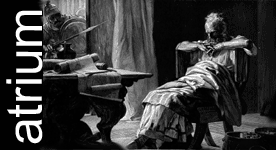From the News and Star:
The original article is accompanied by a picture of a Roman squirrel for some reason ... it appears to be a character from the Tullie House website (which has a neat little feature on a Roman murder victim facial reconstruction) ...
SOME of the most important people to have lived in Cumbria were the Romans, who occupied the land that became Cumbria from about 72/73AD to 500AD.
Hadrian’s Wall is the biggest and most famous Roman archaeological feature, but there are lots of other things that the Romans left behind in Cumbria – some of which can be seen at Tullie House.
From today you can find out all about the Romans in Carlisle (which they called Luguvalium) on a new Tullie House interactive website.
The website – www.tulliehouse.co.uk/romans – is an informative, fun and entertaining resource for pupils and teachers and includes fun activities and useful information that you can use on school projects. Your guides are Rufus the Archaeologist and Roman squirrel.
An interactive map details what the Romans were doing in relation to modern Carlisle. As well as a Roman-style game of snakes and ladders you can reconstruct a skull found at an excavation site at the north end of The Lanes shopping centre.
Richard Clark, a teacher at Stanwix Primary School (which is on the site of the Roman fort Uxelodunum) says that: “The Tullie House Roman website is full of useful information and facts of Roman life in Carlisle. Being able to show children where the Romans lived in comparison with today’s Carlisle is a great way of getting them to learn the history of our city.”
Julie Wooding, Tullie House learning and access officer says the Roman website has taken a lot of hard work and creative skills to get right
“The interactive tools and games ensure the website is fun while still retaining the valuable information needed to help teachers educate children on such an exciting and significant period within Carlisle history,” she says.
The new website is part of the Renaissance project, a national scheme to transform England’s regional museums.
The original article is accompanied by a picture of a Roman squirrel for some reason ... it appears to be a character from the Tullie House website (which has a neat little feature on a Roman murder victim facial reconstruction) ...
